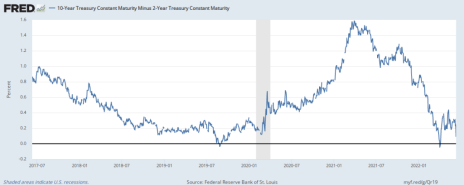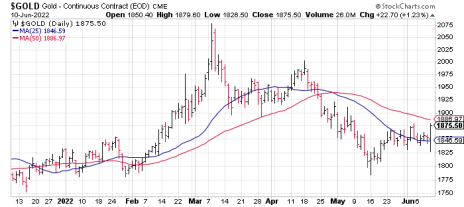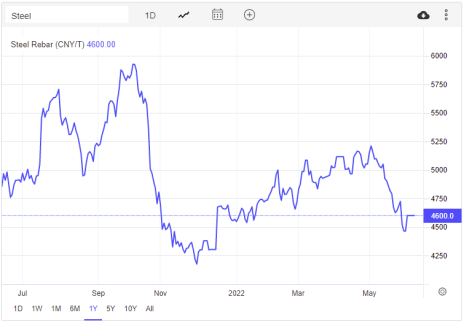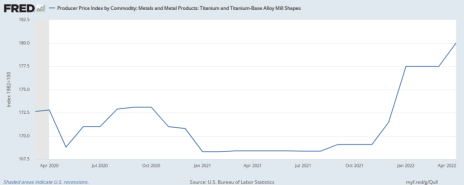After several weeks of underperformance, gold is once again showing promise after the latest round of global equity market weakness. As we’ll discuss here, it’s looking like safety demand for the metal is rising.
Titanium, meanwhile, remains strong and is currently the top-performing metal.
Lithium was shaken by a bearish Goldman Sachs call, but the metal’s trend is still up.
All told, I continue to recommend that we stay on our toes as market turbulence is very high right now.
Cabot SX Gold & Metals Advisor Issue: June 14, 2022
Cratering Confidence Creates a Golden Opportunity
Defensive Investors Turn to Gold
Financial market selling pressure has once again reared its ugly head in the global equity market and the threat of higher inflation is the catalyst, but gold is poised to benefit.
Last week’s release of hotter-than-expected U.S. inflation data sent stocks plunging across the board, as investors worried that the Federal Reserve will have to increase its interest rate hikes to get inflation under control.
The Consumer Price Index (CPI) for May soared to an annual rate of 8.6%, while the core rate rose back to 6% and above expectations. This shocked market participants, resulting in several major stock market indexes giving back much of their recent gains.
Also concerning to investors lately has been the sharp rise in 10-year Treasury yields, which hit a new high for the year on June 10. Consequently, the widely talked about 10-year minus 2-year yield spread (below) is getting closer to inverting again—a potentially bearish omen for the economy, as yield curve inversions typically precede recessions.
An even more shocking economic headline shook up investors when the preliminary University of Michigan Index of Consumer Sentiment for June dropped to 50, an astoundingly low level and well below the consensus expectation.
The latest consumer sentiment reading was down from the final reading of 58 for May and an eye-opening 42% drop from 86 in the same period a year ago. It’s also the lowest reading ever based on records dating back to 1978.
The latest economic numbers further illustrate the tremendous loss in consumer expectations in the face of increasing inflationary pressures. Aside from representing a serious threat to the economy, this loss of confidence has created an ideal backdrop in which gold tends to prosper.
Indeed, the most defensive of all major assets has lately manifested strength in the face of the plethora of bad news. The yellow metal is finally starting to show some liveliness after a disappointing performance in the last three months. While gold was down hard early in the latest (June 10) trading session (when the above-mentioned headlines hit the news wires), the metal recovered strongly in late trading to post an impressive gain for the day.
This shows that while risk assets are no longer in favor at the moment, gold’s “fear factor” is once again in the ascendant, making gold an attractive choice for increasingly safety-oriented investors.
From a technical perspective, gold is now just below its widely-watched (and psychologically significant) 50-day line. If the price can close above the trend line in the next few days, it would turn the metal’s intermediate-term trend positive again. This could also serve as the catalyst for a short-covering event (especially in view of the buildup in negative sentiment on gold in recent weeks).
What to Do Now
After the recent technical improvement in gold, participants recently purchased a conservative position in the GraniteShares Gold Trust (BAR). BAR is my gold tracker of choice when gold prices are on the rise (due to its attractive per-share price), and I’m expecting increasing recession worries among investors to bolster gold’s demand profile. I suggest using a level slightly under 17.94 (the May 13 bottom) as the initial stop-loss on a closing basis. BUY A HALF
New Recommendations/ Updates
Silver’s Best Season Approaches
As we’ve discussed in the last month, silver will soon enter a historically bullish seasonal period starting in July. This factor, combined with the recent technical improvement we’re seeing in other precious metals, suggests we’re getting closer to another potential buy signal for silver.
To reiterate, whenever the silver price enters July in a downtrend, what normally happens is a short-covering pop to higher levels. While this doesn’t always lead to the start of a new sustained (intermediate-term) uptrend, it does typically provide traders with an opportunity to make solid short-term profits.
Moreover, the bullish seasonal period that begins in July tends to last into early September, providing at least a two-month window of opportunity for silver market participants.
There are additional technical and sentiment-based factors that suggest silver could end up having a summer rally. One of them is the recent improvement in hedging activity among commercial players.
Shown here is a chart courtesy of Jason Goepfert’s SentimenTrader, which shows that silver hedging activity has recently triggered a typically bullish “green light” signal. In other words, the “smart money” crowd in the silver market is doing less hedging, which tends to benefit silver prices.
Small speculators, by contrast, have collectively reached one of their most hedged (i.e. bearish) levels in months, according to CFTC Commitments of Traders data. When this happens it frequently produces a contrarian buy signal for silver.
Also worth mentioning is that the ounces of physical silver held by the popular iShares Silver Trust ETF (SLV) has been rapidly falling in recent weeks. This tends to happen when retail investors turn sour on silver, which in turn most often occurs right around bullish turning points for the metal.
In view of these developments, if silver can confirm the price bottom it made a month ago by making a higher peak soon (i.e. by closing above the $22.50 an ounce level), we’ll have another entry opportunity in our favorite silver-tracking ETF.
What to Do Now
From a short-term strategic perspective, no new silver ETF purchases are recommended. WAIT
A June Copper Bottom?
From a seasonal standpoint, an important opportunity is fast approaching for copper. As with silver, the month of July tends to be a critical turning point for the red metal. In fact, based on copper’s performance over the last 30 years, July has been by far its best month in terms of average historical percentage gains.
What the data shows is that around the last week of June is when copper tends to post a bottom (in years when prices were down during that month). Based on the market’s recent action, we should therefore be on the lookout for a price low to be established in the next couple of weeks.
However, unlike silver, copper’s seasonally bullish July performance tends to be very short-lived. The start of August actually begins a bearish tendency for copper prices which continues into the end of the year.
So if history repeats again this year, we should look for a copper bottom later this month, followed by a potentially strong rally in July.
On the news front, it was recently announced that researchers at Ruhr-University Bochum have discovered that copper may soon be utilized more aggressively in the medical industry. The scientists demonstrated that copper is far more effective than antimicrobial silver in killing Covid pathogens.
Using a “sputtering system” in which tiny nanopatches of both metals can be applied to a carrier material, the researchers found “a clear antiviral effect of copper-coated surfaces against SARS-CoV-2 within one hour, while silver-coated surfaces had no effect on viral infectivity,” according to the journal Scientific Reports.
What to Do Now
BHP Group (BHP) is a leading global producer of copper, iron ore, nickel, oil, gas, and metallurgical coal, as well as potash fertilizer. Participants recently purchased a conservative position in BHP using an initial stop-loss slightly under 63 (closing basis). We were stopped out of this position on June 13 when this level was violated in the broad market sell-off. SOLD
Fluor (FLR) is a leading engineering firm, providing construction, maintenance and project management services for the oil and gas, industrial and infrastructure and power generation (including nuclear) industries. The company also offers process expertise in metals and mineral mining, including for gold, copper, coal, nickel and uranium and provides support for fertilizer producers. Management has indicated that dividends and share repurchases are possible as the firm builds its backlog and improve the quality of earnings in cash generation. Analysts see double-digit earnings and revenue growth for this year and next. Participants bought a conservative position in FLR last week using a level slightly under 24.70 (closing basis) as the initial stop-loss. BUY A HALF
Steel Faces Near-Term Headwinds
Steel rebar prices recently hit a five-month low in the wake of Shanghai’s lockdowns, but rebounded last week on prospects that China will begin further relaxation of its tight Covid restrictions.
Futures prices were up 4% from the June 2 bottom, which was the lowest price level of the year to date. Assurances from Beijing that more economic stimulus is on the way also helped buoy steel market sentiment. However, global growth concerns and tighter central bank policies worldwide contained the latest rally attempt.
Another near-term concern for the steel market is that iron ore prices have pulled back in response to a report that Chinese steelmakers are facing margin pressures. (As an aside, net margins for India’s top steel producers in the latest fiscal year were flat at 12%.)
Analysts also fear that profitability for steelmakers could be negatively impacted this year by higher coking coal prices and lower-than-expected increases in realized prices.
However, volume growth reportedly remains healthy across the industry. And Wall Street expects year-over-year revenue growth of around 25% for most of the major U.S.-based steel producers. Thus, it would be decidedly premature to assume the steel bull market has peaked.
What to Do Now
Natural Resource Partners (NRP) is a master limited partnership engaged in owning and managing a diversified portfolio of mineral reserve properties, including steelmaking coal and other natural resources (mainly gas and timber). Participants recently purchased a conservative position in NRP, and after a 10% rally, I recommended selling a half and raising the stop on the remaining position to slightly under 46.50. This level was violated on June 13, which knocked us out of the remainder of our trading position. SOLD
SFL Corp. (SFL) is one of the world’s largest ship owning companies, with investments in the tanker, dry bulk, container and offshore segments with cargoes for metallurgical coal and iron ore. Traders recently purchased a conservative position in SFL using a stop-loss to slightly under 10.50 (closing basis). This stop was triggered by the broad market selling on June 13, so we’re now out of this position. SOLD
The VanEck Steel ETF (SLX) tracks the overall performance of major companies involved in the steel sector. Participants recently purchased a conservative position in SLX using a level slightly under 57 as the initial stop-loss on a closing basis. This stop was triggered on June 13, kicking us out of the position. SOLD
Is the Lithium Bull Dead?
The lithium market was shaken early this month when Goldman Sachs released a research note stating its opinion that the battery metals bull market was “over for now.”
The investment bank said near-record lithium prices reflect a “fundamental mispricing [that] has in turn generated an outsized supply response well ahead of the demand trend.”
While lithium prices for 2022 were predicted by Goldman to average $55,000 a ton, it expects average prices for next year to shockingly plunge to $16,372 (a 70% drop if realized).
Countering Goldman’s bearish narrative, the widely respected Benchmark Mineral Intelligence (BMI) has published a rebuttal. BMI believes Goldman’s forecast is in error for several reasons. One of them is that the battery industry can’t continue relying on low-quality Chinese supplies of the mineral to meet accelerating market demand.
BMI also pointed out that “capacity does not equal supply,” in reference to the growing number of new lithium projects announced (which Goldman partly based its bearish forecast on), noting further that it can sometimes take 10 years or more for a new project to actually begin production.
Moreover, BMI noted that “there is no single lithium price,” meaning that a substantial part of the global market is under long-term fixed price contracts. This suggests that there could be a substantial lag time before spot and contract prices to converge.
For now at least, benchmark lithium carbonate prices in China remain firm and are just 5% under the all-time high level last seen in April.
What to Do Now
Sociedad Química y Minera de Chile (SQM) is a Chilean supplier of fertilizers, iodine, lithium and industrial chemicals. It’s also the world’s fourth-largest lithium producer by market cap and holds a 19% share of the global market for lithium and lithium derivatives. Lithium supply was unable to keep pace with demand in 2021, a trend that SQM’s management expects to continue this year. Additionally, the company is in the midst of a capacity expansion (up to 180,000 tons, and with plans to spend $900,000 this year) which SQM believes will allow it to increase its market share in 2022. SQM posted a stellar 12-times increase in net income for Q1 on the back of strong revenue thanks to higher lithium prices. The results pushed SQM to a string of new highs in late May, prompting us to book a half profit in our trading position in this stock. I now recommend that traders raise the stop-loss to slightly under 85.40 (closing basis), where the 50-day line comes into play. HOLD A HALF
Titanium Bull Marches On
While other key industrial metals like steel and copper are facing short-term challenges, the bull market in titanium marches on.
Titanium and titanium-based alloy prices are trending higher as the global supply situation for the metal continues to tighten.
As it turns out, titanium procurement is an increasingly important issue during war time since the aerospace industry and military rely heavily on the metal for airplane, naval ship and missile production.
This fact was highlighted in a June 10 article in the Real Clear Defense newsletter entitled, “The Dangers of U.S. Reliance on Russian Titanium.” The article notes that the U.S. is a net importer of titanium while Russia is one of the world’s biggest titanium suppliers, which means that U.S. and European defense firms are heavily reliant on Russian titanium, a relationship the article declares as “unhealthy.”
The article concludes by urging Western governments to begin securing alternate titanium supply chains, arguing that continued reliance on Russian product could leave them at the mercy of a major supply shock or catastrophically rising prices.
In the meantime, with China and Russia controlling much of the global market and demand across several industries rapidly expanding, prices should continue trending higher in the intermediate term.
What to Do Now
Kronos Worldwide (KRO) is a leader in the production of titanium dioxide pigments, the world’s primary pigment for providing whiteness, brightness and opacity (used in two-thirds of all pigments). In Q1, the company reported another solid, consensus-beating quarter. Revenue of $563 million was 21% higher from a year ago, while per-share earnings of 50 cents beat estimates by 23 cents, driven by higher titanium dioxide prices. Titanium dioxide segment profit was a whopping 129% higher, due to higher selling prices and higher sales volumes. Going forward, analysts see sales rising 9% and earnings soaring 23% for 2022, which will likely prove conservative. Kronos also declared a 16-cent dividend (4% yield), in line with the previous one. Meanwhile, Deutsche Bank just raised its price target on the stock from 18 to 20. On May 19, I advised traders to take 50% profit in KRO after its 18% rally from our initial entry point. I also recommend raising the stop-loss on the remaining position to slightly under 17 (closing basis). HOLD A HALF
Current Portfolio
| Stock | Price Bought | Date Bought | Price on 6/13/22 | Profit | Rating |
| BHP Group (BHP) | -- | 6/7/22 | -- | -- | Sold |
| Fluor Corp. (FLR) | 27.2 | 5/31/22 | 26.4 | -3% | Buy a Half |
| GraniteShares Gold Trust (BAR) | 18.35 | 6/7/22 | 18.1 | -1% | Buy a Half |
| Kronos Worldwide (KRO) | 15.25 | 4/12/22 | 18.4 | 21% | Hold a Half |
| Natural Resource Partners (NRP) | -- | 1/16/22 | -- | -- | Sold |
| SFL Corporation (SFL) | -- | 5/17/22 | -- | -- | Sold |
| Sociedad Química y Minera (SQM) | 83.5 | 5/17/22 | 92.4 | 11% | Hold a Half |
| VanEck Steel ETF (SLX) | -- | 5/31/22 | -- | -- | Sold |
Buy means purchase a position at or around current prices.
Buy a Quarter/Half means allocate less of your portfolio to a position than you normally would (due to risk factors).
Hold means maintain existing position; don’t add to it by buying more, but don’t sell.
Sell means to liquidate the entire (or remaining) position.
Sell a Quarter/Half means take partial profits, either 25% or 50%.
The next Cabot SX Gold & Metals Advisor issue will be published on June 28, 2022.
Analyst Bio
Clif Droke
Clif Droke is Chief Analyst of Cabot SX Gold & Metals. For over 20 years, he has worked as a writer, analyst and editor of several market-oriented advisory services and has written several books on technical trading in the stock market, including “Channel Buster: How to Trade the Most Profitable Chart Pattern” and “The Stock Market Cycles.”




